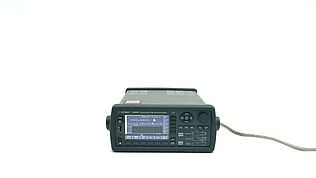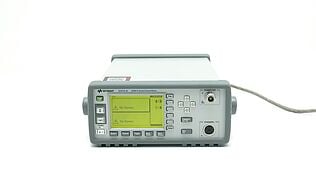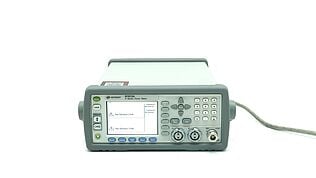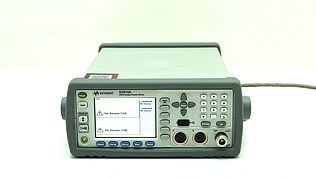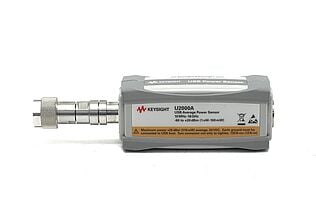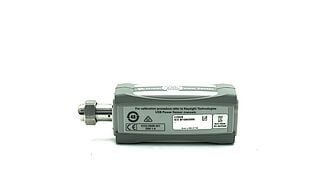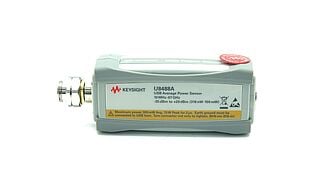- Introduction
- What is a Fuse?
- Types of Fuses
- How to Check if a Fuse is Blown
- How to Choose a Multimeter
- Upgrade Your Toolkit with Keysight's Premium Used Multimeters
- How to Test a Fuse With a Multimeter
- Setting Up
- Continuity Testing
- Resistance Testing
- Voltage Testing
- How to Interpret the Results
- Safety Precautions When Working with Fuses
- Troubleshooting and Common Issues
- How to Maintain and Care for Your Equipment
- Ensure Reliable Measurements and Safe Operations with the Right Multimeter
- Upgrade Your Bench with Keysight's Certified Used Multimeters
- Whenever You’re Ready, Here Are 5 Ways We Can Help You
Have you ever been deep into a project only to have your equipment suddenly stop working? It's frustrating, isn't it? Often, a simple fuse is to blame. For engineers, the task of checking a fuse might seem straightforward, but the fear of accidentally causing a short circuit can make it nerve-wracking.
This guide is designed to walk you through the steps of using a multimeter to safely test a fuse. Here, we'll clear up any confusion and help you confidently handle fuses, so you can get back to your project with peace of mind.
What is a Fuse?
A fuse is a safety device designed to protect electrical circuits from damage caused by excessive current. It's a critical component in preventing electrical fires and safeguarding sensitive electronic equipment.
The basic principle behind a fuse's operation is relatively simple: it features a metallic wire or strip that melts when too much current flows through it. This melting process breaks the circuit, effectively cutting off the electrical flow and preventing further damage or hazard.
Fuses are typically made of materials with a low melting point, such as tin or silver, allowing them to quickly react to overcurrent conditions. By interrupting the power supply, fuses ensure that any abnormal surge of electricity does not reach dangerous levels, thus maintaining the overall safety and integrity of the electrical system.
Types of Fuses
Fuses come in various shapes and sizes, each designed for specific applications and with unique characteristics. Here's a look at some common types of fuses:
- Glass tube fuses: These are cylindrical fuses with a glass body that allows you to see the internal metallic wire. When the wire melts (indicating the fuse has blown), it's visibly clear. Glass tube fuses are often used in automotive and electronic applications. They are valued for their precise response to overcurrent and the ability to quickly inspect fuse status.
- Blade fuses: Also known as spade or plug-in fuses, these are widely used in automotive industries due to their compact size and ease of installation. Blade fuses are color-coded according to their current ratings, making identification straightforward during replacements.
- Ceramic fuses: Stronger than glass tube fuses, ceramic fuses are designed to handle higher current loads and are typically used in industrial applications. Their ceramic casing provides better protection against high temperatures and arcs.
Below is a table comparing these common types of fuses, highlighting their characteristics and typical applications:
| Type of Fuse | Material | Current Rating | Breaking Capacity | Typical Application |
|---|---|---|---|---|
| Glass Tube | Glass, metal | 0.5A to 30A | Low to medium | Electronics, automotive |
| Blade | Plastic, metal | 1A to 40A | Medium | Automotive systems |
| Ceramic | Ceramic, metal | 0.5A to 100A | High | Industrial equipment |
How to Check if a Fuse is Blown
Determining whether a fuse is blown is a critical step in troubleshooting electrical issues. There are a couple of ways to inspect a fuse:
- Visual inspection: The most straightforward method to check if a fuse is blown is by looking at it. For glass tube fuses, examine the filament inside. A blown fuse typically has a broken or visibly damaged wire filament. Additionally, look for signs of blackening or discoloration inside the glass, which indicates that the fuse has burned out.
- Blade and ceramic fuses: While blade and ceramic fuses don’t allow internal visibility like glass fuses, you can often identify a blown fuse by discoloration or melting of the plastic housing in blade fuses. Ceramic fuses might show external signs of scorching or cracking.
- Other signs of a blown fuse: If visual cues are not evident, other signs can indicate a blown fuse:
- Functional failure: If a specific part of your electrical system stops working, but everything else is functioning, a blown fuse could be the culprit.
- Multimeter test: Set your multimeter to the continuity setting. Remove the fuse from its holder (to ensure an accurate reading), and place the multimeter probes on each end of the fuse. A good fuse will show continuity, meaning the internal wire is intact. No continuity means the fuse is blown.
By combining these methods, you can effectively determine if a fuse needs replacing, ensuring that your electrical systems are safe and functional.
How to Choose a Multimeter
Choosing the appropriate multimeter for inspecting fuses is essential to ensure precise measurements and safety. Here are the key features to consider when choosing a multimeter:
- Continuity setting: Essential for checking if a fuse is intact. This setting emits a beep if the circuit is closed, indicating the fuse is good.
- Resistance measurement: Useful for identifying if a fuse has a very high resistance, suggesting it may be nearing failure.
- Voltage capabilities: Ensures you can test the presence of voltage in a circuit, which is important for troubleshooting broader electrical issues.
- Auto-ranging: This feature simplifies operation by automatically selecting the correct range based on the input detected.
- Safety ratings: Look for a multimeter with a suitable safety rating for the environments you'll be working in, such as CAT III.
A multimeter will help you check fuses and assist in other electrical diagnostic tasks, making it a versatile tool in your toolkit.
Upgrade Your Toolkit with Keysight's Premium Used Multimeters
How to Test a Fuse With a Multimeter
Testing a fuse with a multimeter is a straightforward process that requires careful setup and execution to ensure accurate results and maintain safety. Let’s break down the steps starting with how to prepare your multimeter.
Setting Up
Before testing a fuse, ensure your multimeter is correctly set up to prevent damage to the device or personal injury:
- Turn off power: Always make sure to turn off the power to the circuit before working with the fuse.
- Set the multimeter: Rotate the multimeter's dial to the continuity setting, usually indicated by a diode symbol or the word "CONT." This mode is ideal for fuse testing as it checks for a complete path (continuity) within the fuse.
Continuity Testing
Follow these steps to perform a continuity test on a fuse:
- Remove the fuse: Always remove the fuse from its holder to avoid parallel paths that can give false readings.
- Touch the probes: Place the multimeter probes on both ends of the fuse. It doesn't matter which probe goes on which end.
- Listen for the beep: If the multimeter beeps, this indicates continuity, meaning the fuse is good and unbroken. If there is no beep, the fuse is likely blown.
- Inspect the display: Some multimeters also show a numerical value; a high resistance value further confirms a blown fuse.
By following these steps, you can effectively determine whether a fuse is operational or needs replacing, using your multimeter as a reliable diagnostic tool.
Resistance Testing
Measuring the resistance of a fuse can provide insights into its condition. Here's how to conduct a resistance test with a multimeter:
- Ensure safety: Make sure the fuse is completely disconnected from any power source.
- Set the multimeter: Adjust your multimeter to measure resistance, often symbolized by the Greek letter Omega (Ω).
- Connect the probes: Touch one probe to each end of the fuse. Ensure good contact with the fuse's metal caps.
- Read the resistance: Observe the reading on the multimeter. A good fuse typically shows very low resistance, near zero ohms. A blown fuse will show no continuity or infinite resistance, often displayed as 'OL' (overload) on the multimeter.
Voltage Testing
Testing for voltage across a fuse holder can help determine if the circuit is live and if the fuse is functioning properly. Follow these steps to perform a voltage test:
- Safety first: Confirm that the circuit can be safely energized and that it is safe to proceed with testing.
- Set the multimeter: Switch your multimeter to measure voltage. If you are unsure of the expected voltage, set the multimeter to the highest voltage setting initially, then adjust downward as necessary.
- Probe the fuse holder: Insert one probe into each terminal of the fuse holder. Ensure that you do not directly touch the metal probes with your fingers during this test.
- Check the voltage reading: A zero reading typically indicates that the fuse is blown, as there is no complete path for the voltage to travel. A non-zero reading (close to expected line voltage) suggests the circuit is live and the fuse is intact.
These testing methods allow you to evaluate the status of a fuse, ensuring that your electrical systems are both functional and safe.

How to Interpret the Results
Accurately interpreting the readings from your multimeter is essential for determining the exact condition of a fuse. Different readings can indicate whether a fuse is functional, on the brink of failure, or already failed.
Here’s a detailed explanation of what each type of reading means and a table to summarize the information for quick reference.
1. Continuity Test:
- Beep: The fuse is in good condition and does not need replacement.
- No beep: The fuse is blown and needs to be replaced.
2. Voltage Test (across the fuse holder):
- Voltage present (close to expected line voltage): The fuse is intact, and the circuit is live.
- No voltage (0 volts): The fuse is likely blown, especially if other parts of the circuit are still energized.
3. Resistance Test:
- Very low resistance (close to 0 ohms): Indicates a good fuse.
- High or infinite Resistance (OL displayed): Indicates a blown fuse.
| Test Type | Reading | Interpretation |
|---|---|---|
| Continuity | Beep / Low Resistance | Fuse is good, no replacement needed |
| Continuity | No Beep / Infinite Resistance | Fuse is blown, replace it |
| Voltage | Voltage Present | Circuit is live, fuse is good |
| Voltage | No Voltage | Possible blown fuse |
| Resistance | Very Low Resistance | Fuse is good |
| Resistance | High or Infinite Resistance | Fuse is blown |
Understanding these readings will help you to accurately assess the status of a fuse and decide whether it needs to be replaced.
Safety Precautions When Working with Fuses
Working with fuses involves handling electricity, which requires adherence to strict safety protocols to prevent accidents. Here are essential safety measures you should always follow:
- Turn off power: Before attempting to test or replace a fuse, always make sure the power to the circuit is completely shut off.
- Verify power is off: Use a voltage tester or your multimeter to confirm that there is no power in the circuit before starting your work. Never assume the circuit is dead just because the switch is off.
- Use insulated tools: Always use tools with insulated handles when working with electrical components. This extra layer of insulation can protect you from accidental shocks.
- Wear protective gear: Put on appropriate personal protective equipment (PPE) such as rubber-soled shoes, rubber gloves, and safety glasses. These items provide additional protection against electric shock and other physical injuries.
- Check fuse type and size: Always replace a blown fuse with one of the exact same type and rating. Using a higher-rated fuse can lead to overheating and potentially start a fire.
- Avoid touching metal parts: When testing or replacing a fuse, be cautious not to come into contact with any metal parts or terminals with your bare hands.
- Be aware of surroundings: Ensure that the area around your workspace is dry and free from water to avoid electrical hazards. Also, keep the workspace clear of any unnecessary tools or wires.
- Follow manufacturer’s instructions: Always refer to the equipment’s manual for specific safety instructions and recommended procedures related to fuses.
Common Risky Practices and How to Avoid Them
- Bypassing fuses: Never attempt to replace a fuse with a piece of wire or any other conductor as a temporary fix. This can cause more significant damage and pose serious safety risks.
- Ignoring safety signs: If a fuse frequently blows or the electrical system shows signs of issues like flickering lights or unusual sounds, consult a professional. These could be signs of more serious electrical problems.
By following these safety precautions and being mindful of common risky practices, you can safely manage and replace fuses, ensuring both personal safety and the integrity of your electrical systems.
Troubleshooting and Common Issues
During fuse testing, you may encounter a range of issues that can complicate the process. Below are some typical problems along with solutions and tips to handle these challenges.
Inconsistent Multimeter Readings
- Possible cause: Poor contact between the multimeter probes and the fuse terminals.
- Solution: Clean the fuse terminals and the multimeter probes to ensure they are free from dirt and oxidation. Make sure the probes make firm contact with the fuse terminals.
- Tip: If inconsistencies persist, check the multimeter’s battery and consider recalibrating the device if necessary.
Fuse Keeps Blowing
- Possible cause: Overloading of the circuit or a potential short circuit in the wiring.
- Solution: Check the circuit for any faulty or improperly rated appliances that might be causing an overload. Inspect wiring for any signs of damage or shorts.
- Tip: Consider consulting an electrician to diagnose complex issues with the circuit that might be causing fuses to blow frequently.
Unclear Fuse Ratings
- Possible cause: Old or faded labels on the fuse or fuse box making it hard to identify the correct fuse rating.
- Solution: Refer to the equipment’s manual or manufacturer’s website for fuse rating information. You can also consult an electrician to help determine the appropriate fuse type and rating.
- Tip: Label new fuses and the fuse box clearly as you replace them to avoid confusion in the future.
Safety Concerns When Handling Electrical Components
- Possible cause: Inadequate protective gear or unsafe handling practices.
- Solution: Always use the appropriate personal protective equipment (PPE), such as insulated gloves and safety goggles. Ensure that all safety protocols are followed meticulously.
- Tip: Regularly review and update your safety practices and PPE based on the latest industry standards and recommendations.
By addressing these common issues, you can streamline the process of testing and replacing fuses, reduce downtime, and improve safety. Keep these troubleshooting tips in mind to ensure effective maintenance of your electrical systems.
How to Maintain and Care for Your Equipment
Regular maintenance will ensure your multimeter remains reliable and accurate over its lifespan. Here are key practices for keeping your multimeter in top condition.
- Proper storage: Always store your multimeter in a clean, dry place to prevent moisture accumulation and dust ingress. If it comes with a carrying case, use it to protect against physical impacts and environmental damage.
Battery Replacement
- Check regularly: Monitor the battery level of your multimeter. Many devices feature a low battery indicator.
- Replace promptly: Replace the batteries as soon as they begin to run low to avoid inaccurate readings and ensure the multimeter functions correctly when needed.
- Use quality batteries: Opt for high-quality batteries to improve performance and reliability.
Regular Calibration
- Follow manufacturer’s recommendations: Check the user manual for recommended calibration intervals. Calibration is typically advised annually, but more frequent checks may be needed based on usage and operational conditions.
- Seek professional calibration: Use professional calibration services. These services adjust your multimeter to standard measurements and can often repair any issues found during the process.
Cable and Probe Care
- Inspect regularly: Before each use, inspect cables and probes for any signs of wear or damage such as cracked insulation or loose connections.
- Clean gently: Wipe the probes and cords with a dry cloth to remove any dirt or debris. For more stubborn grime, use a cloth dampened with mild detergent.
- Replace if necessary: Replace damaged probes and cords promptly to maintain safety and accuracy.
Avoid Exposure to Extremes
- Temperature and humidity: Keep the multimeter away from extreme temperatures and high humidity, which can affect its components and measurement accuracy.
- Electrical overload: Avoid using the multimeter on circuits that exceed its measurement capabilities as indicated in the specifications to prevent damage.
By following these maintenance guidelines, you can extend the life of your multimeter and ensure it continues to provide precise and reliable measurements.
“For all used equipment, I offer my clients calibration and 1 year warranty.” – Keysight Account Manager
Ensure Reliable Measurements and Safe Operations with the Right Multimeter
Facing the frustration of equipment failure mid-project? Concerned about the safety risks of inaccurate fuse checks? The right tools can prevent these issues and ensure your projects run smoothly without costly interruptions.
Our range of multimeters are designed to tackle these very challenges. They are designed to cater to every level of expertise, offering unmatched reliability, precision, and ease-of-use.
Whether you’re dealing with complex industrial systems or simple home electronics, our tools help maintain the integrity of your work, safeguarding both your projects and personnel.
In this guide, we've explored the importance of using a multimeter correctly to check and replace fuses. We’ve outlined different types of fuses and how to test them, and emphasized the essential safety practices needed for electrical work.
We’ve provided practical solutions to common issues that arise during fuse testing and shared essential tips on maintaining your multimeter for peak performance.
When you choose a Keysight multimeter, you're not just getting a tool; you're investing in reliability and safety.
Our products make accurate test results accessible and affordable. Let us help you achieve precision in every task with equipment that meets your demands—because your success is our commitment.
Upgrade Your Bench with Keysight's Certified Used Multimeters
Select up to 3 instruments to compare
Enable Notifications
In order to use this feature, you need to enable notifications.
Manage notification preferences
Whenever You’re Ready, Here Are 5 Ways We Can Help You
- Browse our premium used network analyzers, oscilloscopes, signal analyzers and waveform generators.
- Call tech support US: 1 800 829-4444
Press #, then 2. Hours: 7am – 5pm MT, Mon– Fri - Talk to our sales support team by clicking the icon (bottom right corner) on every offer page
- Create an account to get price alerts and access to exclusive waitlists.
- Talk to your account manager about your specific needs





